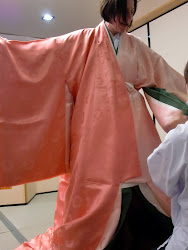
There is a traditional ‘fan tossing game’. After placing a target that looks like a gingko leaf on a wooden box, the players sit on their knees at a distance of about one meter, and take turns tossing an open fan at the target. Then the judge scores them based on the patterns of the positions of the fan, target, and box. As you see at the bottom of
this page , there are numbers of patterns the three objects end up displayed after the tossing.
Each pattern is assigned a certain score depending on the aesthetics of the positions and how much skills and luck it takes to make them happen.
Those patterns are named after the chapters of Murasaki Shikibu's "
The Tale of Genji ".
At Kuroda shop in front of Kyoto Imperial Palace where they dress you up in ‘junihitoe’, they let us a try of this game. kuroda-heisiti@offce.to



 Prior to cherry blossom season, sweets are hinting the blossoms, spring.
Prior to cherry blossom season, sweets are hinting the blossoms, spring.











































